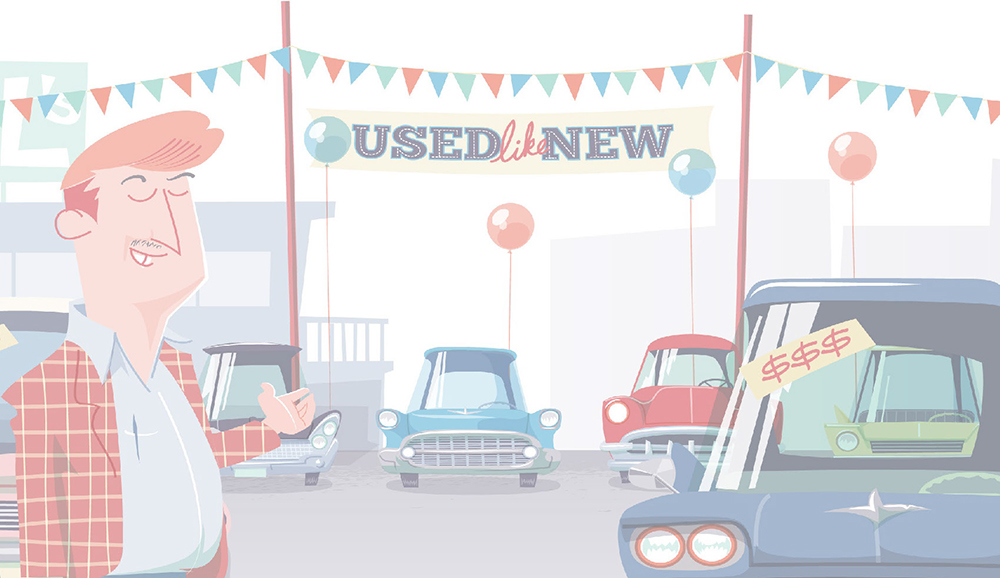In the life cycle of any auto dealership, there will be times when cash flow is tight. Buy here pay here dealers in particular face complexity to ensure enough inventory is on hand to attract buyers — and offset that investment with a healthy flow through collections and debt management. This balance is never perfect. Dealers need strong banking and/or equity relationships that will extend credit to fill in the cash flow gaps.
Debt Management is Proactive
Even if their balance sheet is healthy, dealers on the shy side of $1 million in receivables will likely get a less favorable interest rate on credit than more established or larger dealers. This does not mean that smaller dealers should accept rates of 10 to 15 percent. It pays to shop around and to understand how the bank or private equity firm will consider the characteristics explained above to justify their terms.
By working with your CPA, you can provide the lender with financial statements and accounting that aligns with their expectations. As part of the terms of the loan, dealers may be required to provide reviewed or audited financial statements. Because of this additional expense and also to get more favorable terms, it’s important for dealers to actively seek lower interest rates. It is perfectly acceptable to shop around. Contact competing banks as well as your existing lender and ask about new credit options. Talk to colleagues about the banks they are using. Request multiple offers.
Strong accounting, tax and compliance practices help with this process. On the accounting side, owners need regular financial statement preparation to view trends and forecast cash flow — helping them prepare for lending conversations and extensions of credit at the right time each year. On the tax side, the number one tax planning technique for buy here pay here dealers is the discount (or loss) on the sale of notes from the dealership to the RFC, which requires cash. Dealers may also qualify for opportunities such as bonus depreciation and deductions with regard to employee perks and compensation.
Management may also consider a review of operational efficiencies or gaps in controls that can affect cash flow. Keep in mind that every dealership is different when it comes to managing cash flow, so best practices must occur within your own dealership.
As buy here pay here dealerships grow to portfolios of $4 million and above, more favorable financing opens up. But it’s not a guaranteed scenario. Dealers should weigh the benefits of obtaining more financing against the extra administrative costs of public accounting services.
Once you have the credit you need, there are various ways to reinvest in your business. Some dealers may decide to purchase their location — adding real estate holdings that support the extension of credit in the future. If the dealership also has a service department, cash flow can be set aside to cover repairs and maintenance on recently sold cars. Some dealers choose to cover repairs on cars shortly after purchase in order to support the customer’s ability and willingness to keep making monthly payments. For example, a repair may cost $800, but it leads to another six to 12 months of customer payments.
Compensation is another area that cash flow can support. Attracting and keeping good back office personnel supports collections, which in turn supports the business. Dealers may also consider additional compensation for good salespeople.
Let’s say you’ve done as much proactive management that you can. At certain points in the life of a dealership, you will still experience challenges. Some of these challenges can’t be handled alone. Whether you’re with a big bank and have secured a favorable interest rate or your dealership is still considered high risk for lenders, don’t ignore cash flow problems. Your CPA can help you formulate a plan to show numbers and communicate effectively with lenders in a way that is focused on solutions rather than the immediate problem. Lenders don’t like to call a loan for a short-term issue, and there is usually room for negotiation on loan modifications that will support cash flow as well as repayment.
However, year-over-year problems make lenders less willing to keep taking a risk on default. As soon as an issue comes to light, prepare your strategy to keep a strong lender relationship. Work through it like you and your lender are on the same side. It’s in the best interests of you and the lender to find a solution.
Debt Management Supports Valuation
It is also in the best interests of the dealership long-term to show a consistent history of loan financing, healthy cash flow and debt management. Owners want to show a return on investment and consistent profitability, tied to valuation of the business.
There are different approaches to valuation. A key component, however, is determining equity value, which is the market value of the dealership assets minus the market value of its liabilities.
Assets include such things as the dealership’s auto inventory and fixed assets including real estate. They can include intangible assets such as the goodwill value of the dealership’s name and location, sales and service agreements, and also synergies such as multiple locations and strong management.
Liabilities will include debt, any excess compensation, tax and rent issues, inventories and contingent liabilities such as environmental issues related to the storage and disposal of fuel, oil or batteries.
The bottom line is that a well-performing portfolio, a good location and healthy foot traffic — combined with properly managed debt — will be attractive to a potential buyer. A dealership that is attractive to lenders is also attractive to buyers or outside investors, even with debt factored in.
If your dealership struggles with debt management or cash flow either intermittently or throughout the year, don’t let it hinder opportunities to grow. Talk to the team in Cornwell Jackson’s auto dealership practice group. They will help you understand the proper structure of financial statements to support proactive lender conversations.
Download the Whitepaper: Use Debt to Increase Cash Flow
Scott Bates is an assurance and business services partner for Cornwell Jackson and supports the firms auto dealership practice. His clients include small business owners for whom he directs a team that provides outsourced accounting solutions, assurance, tax compliance services, and strategic advice. If you would like to learn more about how this topic might affect your business, please email or call Scott Bates.
Originally published on February 29, 2016. Updated on April 3, 2018.







